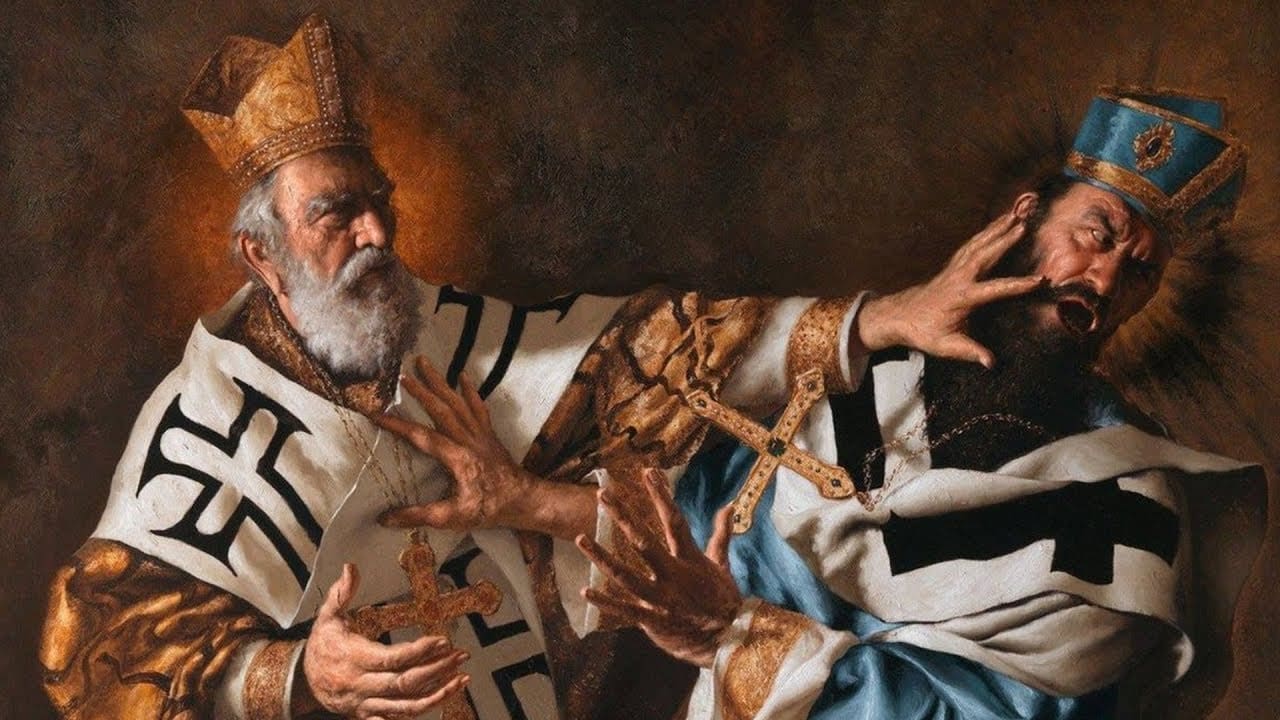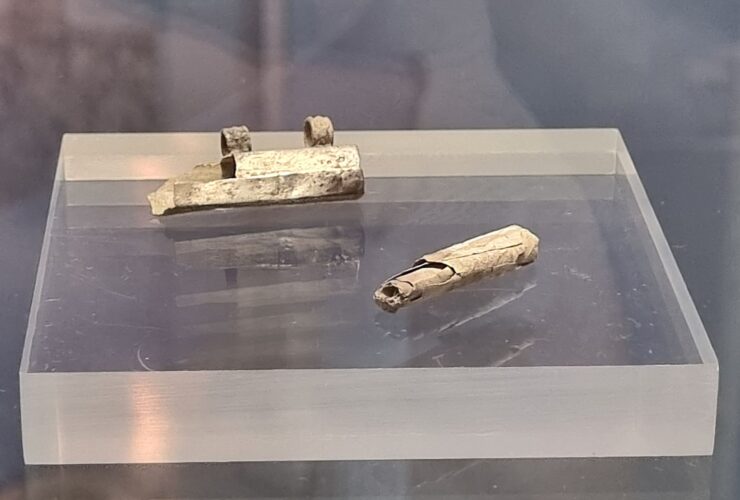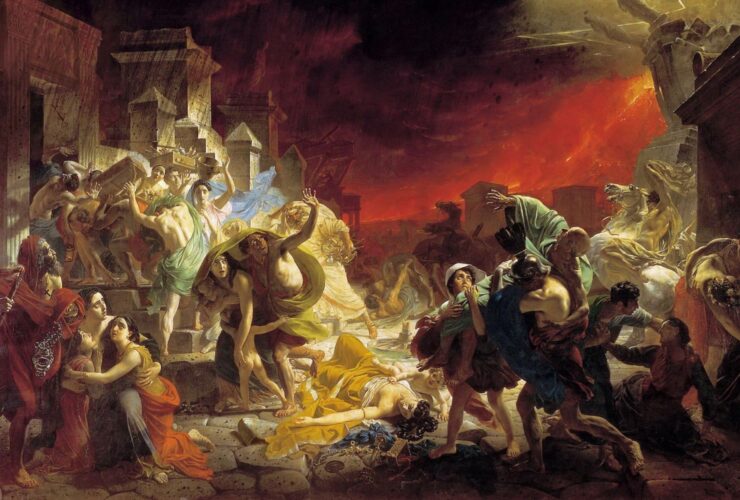It was a cold winter’s night in Nicaea when a sudden blizzard enclosed the known world. Unprecedented as it was, bishops trudged across Christendom by hoof and foot to assemble in what was to be the first real effort to obtain a sacred consensus—the First Ecumenical Council. More than three hundred bishops arrived that night at Emperor Constantine’s imperial palace. Among the merry gentlemen was our beloved Kriss Kringle, or Saint Nicholas as he was better known, the Bishop of Myra.
‘Twas on that twenty-fourth of December in the year of our Lord 325, in timely miracle and concord, that a strong gust of wind puffed the palace doors wide open—and there he stood—snowy boots tarnished with ash and soot and a travel bag of good tidings flung over his shoulder. He looked like a peddler draped all in fur, and had a long priestly beard of sprinkled frost, with butter-scooped dimples, cheeks of roses, and a nose like cherry, hoisting a dinner roll exterior that shook like a bowlful of jelly. He clenched a pipe stump tight in his teeth, and the smoke encircled his head like a halo in yuletide spirit. Nicholas had arrived, jovial as always.
The Council had gathered on that silent, hallowed night to spiritually ratify the most important theological debate of the age: The nature of Jesus Christ in relationship to God the Father. For among the merry was an actual peddler—a seller of heresy, as it were—his name was Arius. You see, Arius was the Archbishop of Alexandria and had long contended Church teaching and tradition on Christ’s divinity. He was pale, dark and slender. He wore a black robe with polished thigh-high boots, and not a speck of dust could be found on him. His face was stern, firm, and unmoving with cheekbones sharper than a dagger’s dozen.
“He is a creature, I say,” said Arius, “It is right there in Scripture, can’t you see? Or are you as blind as the pharisees of old?!”
The room fell silent as if ill. Not a creature dare stir lest the candle light dim. He went on for hours. Accusations abounded, decorated with flattery and jubilance. He sang songs of Christ the creature, broke bread and dipped it in wine. The accuser, Arius, stood triumphant and brazen, shouting blasphemies and opinions I dare not repeat. At the end of his display, he raised his boney finger to heaven and declared, “Jesus is not God!”
Nicholas’ eyes twinkled, and like a piping hot kettle on a winter’s afternoon he stormed down the hall and decked Arius across his smug, cold-cut face. His cheeks, though turned-too-tight, swelled beet red and sagged down his jaw like a lump of coal in seasons’ stocking. It was a joyous moment in the house. Wine was all about, rosy cheeks lit the room, mugs of hot cocoa clattered and the Council was adjourned. Arius’ heresy was no more.
Sanctified Nicholas was in that very moment, for his holy affections could not contain his unadulterated passion for Christ and love for mankind. It was for Arius’ own good, you see. To remind him of what Christmas was truly about.
“Come all ye faithful, all ye joyful and triumphant—take heart!” said Nicholas, “For the Christ, God incarnate, was born in flesh this Day, to save us all from Satan’s pow’r when we were gone astray. Not by men, that we should boast, but by Virgin’s might—the Holy Ghost! Oh, what tidings of comfort and joy!”
Now rumour has it that Arius felt not one, not two, but three punches that night—in the name of the Father, the Son, and the Holy Spirit—his left, his right, and under his chin were as red as burning hot coals. While rumour is subject to fibbery, and we ought to be careful of what we tell is truth, the moral of said hearsay is what is to be remembered. For hearsay, even if only a little true, is often more powerful than heresy. A lie that clings to truth, rather than oppose it, is bound to last that much longer.
Ten years later in the year of the Lord 336, Christmas Day was born. That is why we today call him Santa Claus, a contraction of Saint Nicholas, meaning “A sanctified victory of the people”. As for Arius, well, he died that same year on Christmas Eve, only to meet his comeuppance in the flesh.
This may sound like the end of the story, but it isn’t.

The Real Saint Nicholas
Much like our yuletide season, historical accounts can be decorated with bells, whistles, and boughs of holly—creative liberties abound. And my satirical retelling is no different. For instance, the Council of Nicea was not held on the night of December 24th, it was held from May 20th till August 25th, and Emperor Constantine arrived a month late on June 14th. Summertime, however, does not quite enrapture the spirit of the season, if I do say so. Yet amidst the jesting and fantastical, what is true will often surprise you.
While the life of Saint Nicholas is historically suspect, shrouded in catholic legends, Norse myth, generational telephone, miracles, mystery, and the impossible, as far as I can tell he did indeed thwack Arius (or some other Arian heretic) across the face—just once—in a holy passionate embrace. The earliest surviving recorded of the story is written by the Venetian Bishop of Equilio (AD 1370), Petrus de Natalibus, who was retelling the account he read elsewhere, “It happened that saint Nicholas, now an old man, was present at the Council of Nicaea, and out of jealousy of faith struck a certain Arian in the jaw, on account of which it is recorded that he was deprived of his mitre and pallium; on account of which he is often depicted without a mitre.”[1] It is a rather odd fact to make up. Whether it was punch or slap is unknown, which would make all the difference in his intellectual intent and masculine urges, but its candidness does support its credibility considering such a tale has persisted for over millennia and has only deviated between punch or slap. Even more so, it hurt his class-act reputation at the time as a meek, generous, charitable, pious, and humble servant of God considering he was temporarily deposed as bishop for loosing self-control and then sent to prison because he broke Roman law—violence of any kind was prohibited in Constantine’s court[2]. (Which may also explain why he is not mentioned as a delegate on some of the surviving list of bishops who attended the Council.) The bishops were tasked by Constantine to decide his fate. In prison he asked God for forgiveness and was supposedly visited, so the story goes, by Christ and Mother Mary who broke his chains, materialized a bishop’s robe, and handed him sacred Scripture to read for the night. When the jailer came to him in the morning, his vindication was clear for his vestiges were restored. Nicholas was fully reinstated as Bishop of Myra thereafter. There is a very clear and pragmatic garland of truth tying this account to history, especially since his thwack is not necessarily out of his character, either, according to other biographical accounts—he is quite the man of action, whether disarming executioners, assailing pagan shrines, destroying the Temple of Artemis, seizing the Emperor in his dreams, freeing slaves or lowering taxes—so it seems here, also, he simply wanted to knock some penitence into the man, and perdition out of him.
To be fair, Christians were intensely persecuted until that time, each bishop bearing scars on back and bone to prove it. Constantine was the first Roman Emperor to not only legalize Christianity in AD 313, ending centuries of persecution, but he made it the official state religion in AD 324 as a way to unify the Empire. In so doing, he paid for the entire Council, including the bishops’ travel expenses, giving them free transportation on the imperial postal system. And here comes a man, Arius, attempting to discredit the whole edifice of the faith. The tension couldn’t be higher.
As for the real Saint Nicholas, the night was not over nor was the Council adjourned after the fact. According to tradition, he alongside the other merry men of Christ, unified in the Spirit, defended the faith and penned these incontrovertible words for kingdom come—the Nicene Creed:
We believe in one God,
the Father almighty,
maker of heaven and earth,
of all things visible and invisible.
And in one Lord Jesus Christ,
the only Son of God,
begotten from the Father before all ages,
God from God,
Light from Light,
true God from true God,
begotten, not made;
of the same essence as the Father.
Through him all things were made.
For us and for our salvation
he came down from heaven;
he became incarnate by the Holy Spirit and the virgin Mary,
and was made human.
He was crucified for us under Pontius Pilate;
he suffered and was buried.
The third day he rose again, according to the Scriptures.
He ascended to heaven
and is seated at the right hand of the Father.
He will come again with glory
to judge the living and the dead.
His kingdom will never end.
And we believe in the Holy Spirit,
the Lord, the giver of life.
He proceeds from the Father,
and with the Father and the Son is worshiped and glorified.
He spoke through the prophets.
We believe in one holy catholic and apostolic church.
We affirm one baptism for the forgiveness of sins.
We look forward to the resurrection of the dead,
and to life in the world to come. Amen.
Now the moral of this Christmas tale is twofold. For one, the vitality and power of myth and hearsay is proof of its significance. Santa Claus is pure mythos, yet he is the secular icon of the Christmas season, and many people of various religious traditions find his ritual of leaving out milk and cookies in the night endearing, familial, and jovial. Likewise, the mixed accounts surrounding Nicholas’ life have reverberated throughout history, yet clearly have kernels of truth embedded within them that ought to be heeded. If fantasy is here to stay, and its themes are a far cry from fiction but convey truth to be remembered and ritualized, bearing fruit in real-world application, why not have the tradition point to what’s true? The real Santa was zealous for the true meaning of Christmas, and we would do well to fight for Christ, too; but not with a punch (though, it does seem that many need a good old fashion walloping nowadays!), but in the way Saint Nicholas was canonized: feeding the poor in famine, protecting orphans from slavery, providing for widows, guarding the needy and helpless, giving exuberant gifts with no strings attached, saving the spiritually sick from certain death, advocating for justice and defending the Christian faith among other kinds of good works; not in greed and gluttony and selfish ambition, indulging in milk and cookies, turduckens and pastries, but in meekness and humility, generosity and charity. It is the season of giving and self-sacrifice, the good works of which point to the ultimate gift a man could give: Salvation in Jesus Christ our Lord.
I leave that with you, and a very, many thank yous for subscribing.
Merry Christmas to all, and to all a good fight!

Matlock Bobechko is the Chief Operating/Creative Officer of Bible Discovery. He is an eclectic Christian thinker and writer, award-winning screenwriter and short filmmaker. He writes a blog on theology, apologetics, and philosophy called Meet Me at the Oak. He is also an Elder at his local church.
[1] Anrich Volume I, testimonia section, 459.
[2] The oldest edition of his work was printed in Venice in 1570, written by an obscure Damaskenos Monachus or Damascenos the Monk, Life of saint Nicholas the wonder-worker: Large collection of lives of saints, or “Great Book of Saints”. (Const. Chr. Doukakis, Athens. December 20, 1896), 171-190.






